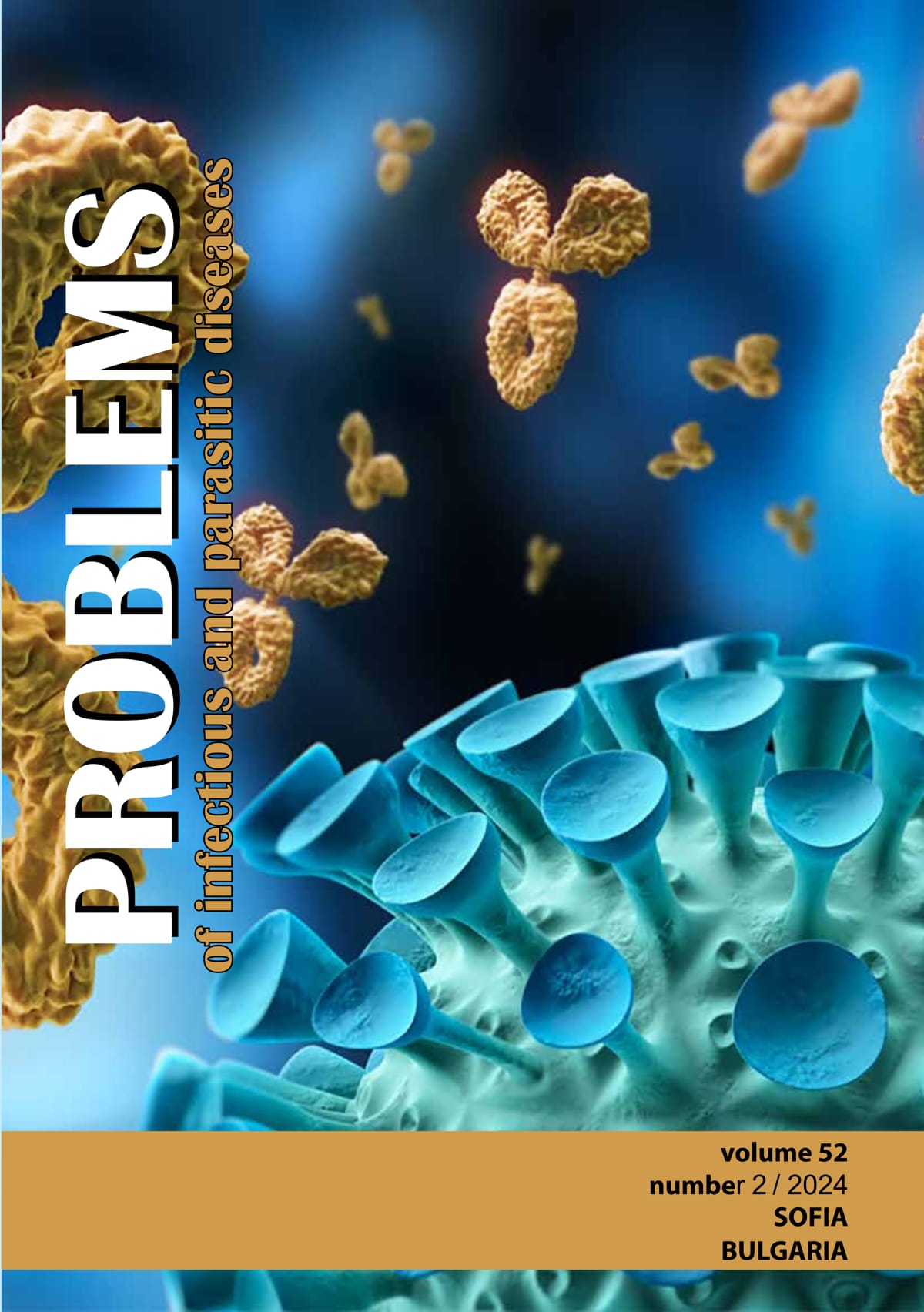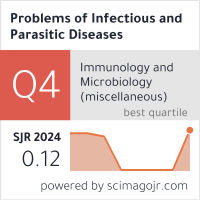MOLECULAR SURVEILLANCE OF GONOCOCCAL CIPROFLOXACIN SUSCEPTIBILITY/RESISTANCE IN BULGARIA, 2022-2023
DOI:
https://doi.org/10.58395/qs4eyy02Keywords:
Bulgaria, gonorrhea, Neisseria gonorrhoeae, ciprofloxacin, antimicrobial resistanceAbstract
Background: The emergence and spread of antimicrobial resistance in Neisseria gonorrhoeae is a significant public health issue, with Euro-GASP conducting surveillance across the EU-EEA. The advent of molecular diagnostics for N. gonorrhoeae may possibly limit the surveillance data because it is dependent on gonococcal culture for phenotypic susceptibility testing. Ideally, molecular diagnostics should combine identification and resistance detection but the complexity of gonococcal molecular genetics of resistance is a major barrier for test development. Currently, resistance prediction in N. gonorrhoeae is accurate only for fluoroquinolones and there are commercial kits available on the market that allow antimicrobial resistance surveillance and individualized treatment. The study examined Bulgaria's gonococcal fluoroquinolone resistance rate for 2022-2023 by molecular methods and compared it with previous years and EU-EEA trends.
Methods: The commercial ResistancePlus® GC assay was used to predict ciprofloxacin susceptibility/resistance in 66 Neisseria gonorrhoeae-positive DNA samples from patients, diagnosed in 2022-2023.
Results: The identified fluoroquinolone resistance rate in 2022-2023 was 68.2%. The majority of the cases were males in the age group 20-29 (50.8%), the most common mode of transmission was MSM (77%) and 17% of the cases with known HIV status were positive.
Conclusion: This study found a higher than before fluoroquinolone resistance rate (68.2%) in Bulgaria, following the trend in Europe. In the EU-EEA, ciprofloxacin resistance increased to 65.9% in 2022. Molecular testing for predicting susceptibility/resistance is suitable for effective antimicrobial resistance surveillance and individualized treatment decisions.
Downloads
References
1. Bennett, J. E., Dolin, R. & Blaser, M. J. Mandell, Douglas, and Bennett's Principles and Practice of Infectious Diseases E-Book: 2-Volume Set. (Elsevier health sciences, 2019).
2. Tang, E. C. et al. Characterizing the Rise of Disseminated Gonococcal Infections in California, July 2020-July 2021. Clin. Infect. Dis. 76, 194-200 (2023). https://doi.org/10.1093/cid/ciac805
3. European Centre for Disease Prevention and Control. Surveillance atlas of infectious diseases. https://www.ecdc.europa.eu/en/surveillance-atlas-infectious-diseases (2024).
4. European Centre for Disease Prevention and Control. Gonorrhoea. In: ECDC. Annual epidemiological report for 2022. Stockholm: ECDC. (2024).
5. European Centre for Disease Prevention and Control. Gonorrhoea. In: ECDC Annual Epidemiological Report for 2017. Stockholm: ECDC. 1-5 (2017).
6. National Center of Public Health and Analyses & MoH. Annual analysis of infectious diseases in Bulgaria. https://ncpha.government.bg/index/3031-godishni-danni.html (2024).
7. Unemo, M. et al. 2020 European guideline for the diagnosis and treatment of gonorrhoea in adults. Int. J. STD AIDS (2020). https://doi.org/10.1177/0956462420949126
8. Unemo, M., Golparian, D. & Eyre, D. W. Antimicrobial resistance in Neisseria gonorrhoeae and treatment of gonorrhea. Neisseria gonorrhoeae methods Protoc. 37-58 (2019). https://doi.org/10.1007/978-1-4939-9496-0_3
9. Fifer, H., Saunders, J., Soni, S., Sadiq, S. T. & FitzGerald, M. 2018 UK national guideline for the management of infection with Neisseria gonorrhoeae. Int. J. STD AIDS 31, 4-15 (2020). https://doi.org/10.1177/0956462419886775
10. Workowski, K. A. Sexually transmitted infections treatment guidelines, 2021. MMWR. Recomm. Reports 70, (2021). https://doi.org/10.15585/mmwr.rr7004a1
11. Meyer, T. & Buder, S. The Laboratory Diagnosis of Neisseria gonorrhoeae: Current Testing and Future Demands. Pathog. (Basel, Switzerland) 9, (2020). https://doi.org/10.3390/pathogens9020091
12. Golparian, D. & Unemo, M. Antimicrobial resistance prediction in Neisseria gonorrhoeae: current status and future prospects. Expert Rev. Mol. Diagn. 22, 29-48 (2022). https://doi.org/10.1080/14737159.2022.2015329
13. Golparian, D. et al. Antimicrobial-resistant Neisseria gonorrhoeae in Europe in 2020 compared with in 2013 and 2018: a retrospective genomic surveillance study. The Lancet Microbe 10, 1-11 (2024).
14. Hadad, R. et al. Evaluation of the SpeeDx ResistancePlus® GC and SpeeDx GC 23S 2611 (beta) molecular assays for prediction of antimicrobial resistance/susceptibility to ciprofloxacin and azithromycin in Neisseria gonorrhoeae. J. Antimicrob. Chemother. 76, 84-90 (2021). https://doi.org/10.1093/jac/dkaa381
15. Allan-Blitz, L. T., Adamson, P. C. & Klausner, J. D. Resistance-Guided Therapy for Neisseria gonorrhoeae. Clin. Infect. Dis. 75, 1655-1660 (2022). https://doi.org/10.1093/cid/ciac371
16. Klausner, J. D. et al. Resistance-Guided Treatment of Gonorrhea: A Prospective Clinical Study. Clin. Infect. Dis. 73, 298-303 (2021). https://doi.org/10.1093/cid/ciaa596
17. Philipova, I., Levterova, V., Simeonovski, I. & Kantardjiev, T. High rate of fluoroquinolone resistant Neisseria gonorrhoeae detected by molecular surveillance of antimicrobial resistance determinants in Bulgaria. Biotechnol. Biotechnol. Equip. 36, 942-948 (2022). https://doi.org/10.1080/13102818.2022.2146532
18. Goire, N., Nissen, M. D., LeCornec, G. M., Sloots, T. P. & Whiley, D. M. A duplex Neisseria gonorrhoeae real-time polymerase chain reaction assay targeting the gonococcal porA pseudogene and multicopy opa genes. Diagn. Microbiol. Infect. Dis. 61, 6-12 (2008). https://doi.org/10.1016/j.diagmicrobio.2007.12.007
19. Melendez, J. H. et al. Can ciprofloxacin be used for precision treatment of gonorrhea in public STD clinics? Assessment of ciprofloxacin susceptibility and an opportunity for point-of-care testing. Pathogens 8, 189 (2019). https://doi.org/10.3390/pathogens8040189
20. European Centre for Disease Prevention and Control. Gonococcal antimicrobial susceptibility surveillance in the European Union/European Economic Area - Summary of results for 2022. (2024).
21. Philipova, I. et al. PREVALENCE OF NEISSERIA GONORRHOEAEAND MYCOPLASMA GENITALIUM IN BULGARIAN POPULATION FROM SOFIA MUNICIPALITY OF REPRODUCTIVE AGE, 2018-2019. Probl. Infect. Parasit. Dis. 49, 20-26 (2021). https://doi.org/10.58395/pipd.v49i2.56
22. Tao, X., Ghanem, K. G., Page, K. R., Gilliams, E. & Tuddenham, S. Risk factors predictive of sexually transmitted infection diagnosis in young compared to older patients attending sexually transmitted diseases clinics. Int. J. STD AIDS 31, 142-149 (2020). https://doi.org/10.1177/0956462419886772
23. Kalichman, S. C., Pellowski, J. & Turner, C. Prevalence of sexually transmitted co-infections in people living with HIV/AIDS: systematic review with implications for using HIV treatments for prevention. Sex. Transm. Infect. 87, 183 LP - 190 (2011). https://doi.org/10.1136/sti.2010.047514
24. Lami, F. et al. Incidence and spontaneous clearance of gonorrhea and chlamydia infections among men who have sex with men : a prospective cohort study in. 1-9 (2024) doi:10.3389/fpubh.2024.1348686. https://doi.org/10.3389/fpubh.2024.1348686
25. World Health Organization. Global health sector strategies on, respectively, HIV, viral hepatitis and sexually transmitted infections for the period 2022-2030. (2022).
26. World Health Organization. Global action plan to control the spread and impact of antimicrobial resistance in Neisseria gonorrhoeae. https://apps.who.int/iris/%0Ahandle/10665/44863.
27. Jensen, J. S. & Unemo, M. Antimicrobial treatment and resistance in sexually transmitted bacterial infections. Nat. Rev. Microbiol. (2024) doi:10.1038/s41579-024-01023-3. https://doi.org/10.1038/s41579-024-01023-3
28. Hadad, R., Cole, M. J., Ebeyan, S., Jacobsson, S. & Tan, L. Y. Evaluation of the SpeeDx ResistancePlus. J. Antimicrob. Chemother. 2611, 84-90 (2021). https://doi.org/10.1093/jac/dkaa381
29. Allan-Blitz, L.-T. et al. Improved determination of Neisseria gonorrhoeae gyrase A genotype results in clinical specimens. J. Antimicrob. Chemother. 74, 2913-2915 (2019). https://doi.org/10.1093/jac/dkz292
30. Golparian, D. & Unemo, M. Antimicrobial resistance prediction in Neisseria gonorrhoeae: current status and future prospects. Expert Rev. Mol. Diagn. 22, 29-48 (2022). https://doi.org/10.1080/14737159.2022.2015329
Downloads
Published
Issue
Section
License
Copyright (c) 2024 Ivva Philipova, Elena Birindjieva, Venelina Milanova, Viktoriya Levterova (Author)

This work is licensed under a Creative Commons Attribution 4.0 International License.






